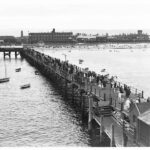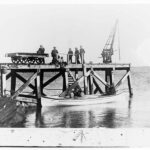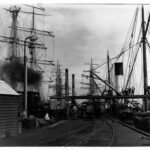Jetties (or ‘piers’) were crucial to early South Australia. Small vessels provided the main means of communication with many isolated coastal settlements and their hinterlands. Jetties allowed safer and more efficient handling of livestock, agricultural produce, passengers, mail and general goods transported by sea. They also provided for the storage and launching of lifeboats, sites for navigation lights, berths for pilot vessels and convenient places for undertaking customs and immigration procedures.
Servicing new areas and new aspects
In the 1870s and 1880s jetty numbers increased as new areas opened up. While the government built many jetties, others were the result of local funding (Brighton near Adelaide) or private enterprise (Largs near Outer Harbor and Port Vincent on the eastern coast of Yorke Peninsula). As ships grew larger jetties were extended to deeper water. Arno Bay jetty had three extensions and by 1906 Port Germein jetty on Spencer Gulf was, at 1664m, the longest in the state.
Some jetties included entertainment facilities, such as the refreshment pavilion built at the end of the Glenelg jetty in 1906, and the aquarium added in 1929. At Semaphore, on Gulf St Vincent near Port Adelaide, there were sea baths (1888) and a refreshment kiosk with an upstairs room for dances (1914).
Government control
The Marine Board controlled most marine jetties and some jetties on the River Murray and its lakes. From 1888 unprofitability and high maintenance costs prompted the government to transfer many jetties to local government control, but when councils encountered difficulties the Marine Board resumed control of some. Subsequently, the Harbors Act 1913 appointed the new Harbors Board as the authority controlling jetties.
Improved transport and communication systems reduced reliance on coastal shipping. From 1914 Harbors Board policy favoured deep-water ports with facilities to service large districts. Working jetties received priority, especially after the Second World War when costs rose, labour and materials were in short supply and there was a backlog of maintenance. Bulk handling of grain further reduced the number of export jetties, road transport competed with intrastate shipping and coastal trade waned. By 1957 the Harbors Board maintained more jetties for promenade and fishing purposes than for shipping.
During the 1970s the Department of Marine and Harbors began to demolish all or parts of unprofitable jetties to reduce maintenance costs. Apart from privately owned jetties, including BHP’s at Whyalla and Mobil Oil’s at Port Stanvac, restructuring from 1989 led to the new South Australian Ports Corporation controlling commercial shipping jetties such as those at Port Lincoln (Eyre Peninsula), Thevenard (West Coast) and Wallaroo (Yorke Peninsula), with the Department of Transport, private owners, local councils and, occasionally, the fishing industry responsible for fishing and recreational jetties.







Comments
One response to “Jetties”
Was there a jetty at Seacliff Beach in the 1950s/60s?